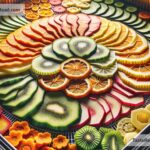The Science of Food Crystallization: Sugar and Ice Explained Simply
Have you ever wondered how your ice cream stays smooth or why sugar can turn into crunchy crystals in candy? The answer lies in an incredible process called food crystallization! It’s a fascinating area of science that affects the texture, flavor, and appearance of many of your favorite foods. Luckily, you don’t need to be a scientist to understand the basics. Let’s dive into the world of sugar and ice crystals and explore how they shape what we eat.
What is Crystallization?
Crystallization is a process where molecules or particles arrange themselves in a structured, repeating pattern to form a solid. Think of crystals like tiny, organized building blocks. Sometimes, crystals are large and easy to see, like the ones found in rock candy. Other times, they’re so small you can’t see them, like in ice cream.
In food, crystallization plays a crucial role in creating texture—whether that’s the crunch of candy, the smoothness of frozen desserts, or the clear perfection of ice cubes in your drink.
Sugar Crystals: Rock Candy and Beyond
Sugar is one of the most common ingredients in food, and it’s also great at forming crystals. If you’ve ever made rock candy at home, you’ve seen sugar crystallization in action. You dissolve sugar in hot water to make a supersaturated solution (meaning there’s more sugar than the water can hold at room temperature). As the solution cools, the sugar molecules start sticking together, forming large crystals.
What makes sugar crystals grow faster or slower? Here are three key factors:
-
Temperature: Warm solutions hold more sugar than cold solutions. As the solution cools, excess sugar forms crystals. If you cool it slowly, the sugar gets more time to organize into large crystals. If you cool it quickly, the crystals tend to stay small.
-
Impurities: Having tiny particles or other ingredients in the solution can disrupt crystal growth. For example, if you add corn syrup to a sugar mixture, it prevents large sugar crystals from forming, which is perfect for chewy fudge or smooth caramel.
-
Agitation: Stirring or moving the solution as it cools can affect crystallization. If the solution is left still, the molecules have more time to form organized patterns, creating bigger crystals. If stirred, the crystals stay smaller.
Sugar crystallization is behind many delicious treats, from gritty rock candy to smooth, creamy chocolate. By controlling how sugar crystallizes, food scientists and chefs create different textures for candies, syrups, and baked goods.
Ice Crystals: The Smooth or Crunchy in Frozen Foods
Now let’s talk about ice. Ice crystallization happens when water molecules freeze and arrange themselves in a structured pattern. When this happens in food, the size of the ice crystals can make a huge difference.
For example, in ice cream, we want the ice crystals to be very small to create a smooth texture. If the crystals are too big, the ice cream will feel crunchy or icy instead of creamy. But how do we control the size of ice crystals in frozen foods?
-
Freezing Speed: Fast freezing creates smaller crystals. That’s why ice cream made with liquid nitrogen (which is extremely cold) feels especially smooth. On the other hand, slow freezing gives water molecules more time to gather into bigger crystals.
-
Stirring: Ice cream machines stir the mixture as it freezes. This keeps the water molecules moving, preventing large crystals from forming and maintaining a creamy texture.
-
Ingredients: Similar to sugar crystallization, the ingredients added to a frozen dessert can influence the outcome. Adding fats and stabilizers (like guar gum and xanthan gum) helps keep ice cream smooth by interfering with ice crystal growth.
Even in water, ice crystallization can lead to interesting results. You might notice cloudy ice cubes in your freezer—this happens when impurities or trapped air disrupt the ice crystal structure. Fancy cocktail bars often filter water and freeze it very slowly to get perfectly clear ice cubes.
The Role of Food Scientists
Food crystallization isn’t just about experimenting in your kitchen—scientists study it to make food better every day. They use their knowledge to solve problems like preventing sugar crystals in syrup or stopping large ice crystals from ruining frozen meals. They also create new textures that delight our taste buds, like the soft crunch of cotton candy or the silky smooth feel of mousse.
Understanding crystallization doesn’t just help with desserts—it’s important for bread, cheese, chocolate, frozen vegetables, and even pet food!
Fun Experiments at Home
Want to try food crystallization yourself? Here are two easy experiments:
-
Rock Candy: Dissolve sugar in boiling water, cool it, and pour it into a jar. Hang a string or stick into the solution, and within a few days, you’ll see sugar crystals grow!
-
Homemade Ice Cream: Mix cream, sugar, and vanilla extract, then freeze it in an ice cream maker or a bag full of ice and salt. The stirring and cooling will help keep the ice crystals small so you can enjoy a creamy treat.
Crystals in Every Bite
From the sugar crystals in your sweet treats to the ice crystals in frozen foods, crystallization plays a big role in what we eat. By understanding this science, we can appreciate the care and creativity that goes into making the foods we love. So, next time you crunch into rock candy or enjoy a scoop of smooth ice cream, give a little thought to those mesmerizing food crystals—they’re science you can taste!


